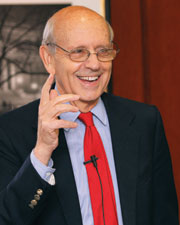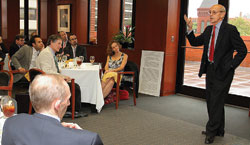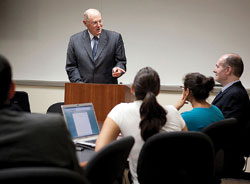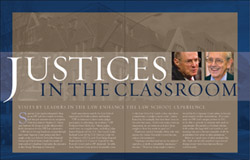Justices in the Classroom
Visits by leaders in the law enhance the law school experience
Supreme Court justices frequently drop in on GW Law for a variety of events, and this past semester was no exception. Visits from Justices Stephen G. Breyer and Anthony M. Kennedy in the fall provided lively discussions for the GW Law community.
GW's ties to the top bench are not just through such visits. Supreme Court justices also have taught at the Law School. Both John Marshall Harlan and David Brewer taught for nearly 20 years each at Columbian University, the precursor to the George Washington University.
Such associations enrich the Law School experience for both students and faculty.
"GW is fortunate to have many judges participate in educating our students," GW Professor Brad Clark says. "Many judges teach here on a regular basis, including Judge James Halpern [of the U.S. Tax Court], Judge Richard Leon [of the U.S. District Court for the District of D.C.], and Chief Judge Randall Rader [of the U.S. Court of Appeals for the Federal Circuit and a GW alumnus]. In addition, Supreme Court justices frequently come to the Law School to teach a class, introduce a symposium, or judge a moot court. Justice Kennedy, for example, has been here twice in the past two years. Such visits make a lasting impression on our students and give them insight to how law works in practice."
Third-year student Natasha Akda, who was present for Justice Kennedy's recent lecture, echoes this sentiment.
"Studying constitutional law in the nation's capital is, in itself, a remarkable experience," she says. "However, being taught constitutional law by a Supreme Court justice is beyond most people's wildest expectations. It's a testament to GW Law's unique position in D.C. to be able to provide its students with such an opportunity. [Kennedy] is a brilliant scholar, both within the legal field and outside it, and meeting him was a distinct reminder of all the possibilities that await us after graduation."
Below is a small taste of what students like Ms. Akda and faculty members experienced during recent visits from Justices Breyer and Kennedy.
Revisiting 'The Uneasy Case'
Supreme Court Justice Breyer discusses his seminal 1970 article on copyright at GW Law symposium
 Forty years after the publication of U.S. Supreme Court Justice Stephen G. Breyer's oft-cited article on copyright law, "The Uneasy Case for Copyright: A Study of Copyright in Books, Photocopies, and Computer Programs," 84 Harv. L. Rev. 281 (1970) technology has pressed rapidly ahead. The lessons offered by the article, however have weathered the march of time, as scholars recounted at a GW Law symposium this fall.
Forty years after the publication of U.S. Supreme Court Justice Stephen G. Breyer's oft-cited article on copyright law, "The Uneasy Case for Copyright: A Study of Copyright in Books, Photocopies, and Computer Programs," 84 Harv. L. Rev. 281 (1970) technology has pressed rapidly ahead. The lessons offered by the article, however have weathered the march of time, as scholars recounted at a GW Law symposium this fall.
The take-aways still are relevant to students and professors of law—much as they are for the author himself, who penned the article as a Harvard Law professor.
The day Justice Breyer handed a bloated 200-page manuscript to then-Harvard Law Dean Derek Bok was "one of the less pleasant days of my life," he said in early November, during an intimate, free-wheeling and often funny keynote speech at the symposium celebrating the paper's 40th anniversary.
"Y'know," he recalled having been told by Dean Bok, MA '53, "when you write something, it's sometimes worth going over it again.'"
For the young professor, who had been nervous to begin with—it was his first attempt at getting published, and his tenure depended on it—the conversation was "sort of heart-stopping."
The paper went through several revisions. Each time Justice Breyer was careful to "pick out those things that I thought were the most interesting, and put the second-most in the footnotes," he said with a smile, "and third-most in the waste basket."
(Of the year and a half spent researching, writing, and revising, he deadpanned: "I think it had a happy ending, the article, because I did get tenure.")
The process was a lesson, in part, about consideration for the valuable time of others—not entirely unlike some of the copyright issues Justice Breyer wrestled with in the text of that December 1970 Harvard Law Review article itself.
In the paper, he weighs the arguments for and against copyright protection, including that of sixth-century King Diarmed, who proclaimed on the subject: "To every cow its calf."
It's a fair point, Justice Breyer said at the symposium. But "many people … stopped right after that; that was their analysis of copyright," failing to consider that barely any worker is given a "moral right to obtain every penny" of worth from their work. That kind of thinking, he said, has waned in the years since the article's publication.
He also referenced, as in his article, a remark by 19th- century politician and writer Thomas Babington Macaulay, who said that copyright was "a tax on readers for the purpose of giving a bounty to writers."
That notion, said Justice Breyer, opens up the heart of the issue: "Put that way, you have to say: What should that bounty be? Why are we giving it? And how much? And what are the circumstances? And under what conditions? And when does it expire?"
"It was an effort to show that economics matters" in copyright law, he said, "... and you don't need to go up and draw diagrams and various things in order to show that." He hoped it also helped law professors realize that although "we're not Immanuel Kant, I'm not John Stuart Mill, there is still lots of useful work to be done."
It's Justice Breyer's approach to the article, more than its long-outdated conclusions, that gives the paper its enduring value, says GW Law Professor Robert Brauneis, who organized the symposium and is co-director of the Intellectual Property Law Program.
That approach, he says, is built on "a transparent and pragmatic theoretical framework, and an insistence on gathering empirical evidence and following it where it leads"—features that have, he said, become hallmarks of the justice's work in the decades since.
In introducing Justice Breyer, former GW Law Dean Frederick M. Lawrence offered the title "public intellectual," a phrase that he said should be reserved for thinkers who analyze issues in a deliberate and unique way; a way that—whether or not the audience is persuaded—shifts the course of the discussion.

Justice Breyer discusses his seminal article, "The Uneasy Case for Copyright," with attendees at a GW Law symposium honoring the paper's 40th anniversary.
Abdul El-Tayef
"I would say that using the bully pulpit of the court, not to walk away from those responsibilities, but to embrace them as a public intellectual may be the greatest gift that you have given us in the legal academy and, really, in the country," Dean Lawrence said.
The day-long symposium—sponsored by The GW Law Review, GW's Intellectual Property Law Program, and the Munich Intellectual Property Law Center—also featured an array of scholars from within the university, across the country, and abroad. On several panels, they discussed economic factors involved, copyright across various industries, the history of copyright, the law of fair use, and copyright in the era of iTunes, Kindle, and other digital means.
Reflecting on his first scholarly journal article during his keynote, Justice Breyer said he was very pleased to know that "somebody still finds this useful."
He recalled Dean Bok once telling him: "You graduated high in your law school class—well I'll tell you something: Every year there are quite a few people who do, at quite a few law schools." The point, Dean Bok told him, is that "ultimately, people will judge you professionally not by your IQ score, but by what you give to them."
Producing that kind of work is "emotionally very satisfying," Justice Breyer said, and "as I get older that becomes absolutely more and more true."
After his address, Justice Breyer opened the floor to questions, during which he spoke about his new book, Making Our Democracy Work: A Judge's View, the reverence of the American people for the rule of law, and the work of the Supreme Court.
"This is an institution that has the power it does because Hamilton thought, correctly, that it will often—or sometimes, anyway—have to make decisions that are quite unpopular; very unpopular," he said. "And it's there to assure the least popular person in the United States that his or her constitutional rights will be identical to those of the most popular person."
And the people on the high court's bench "are not nine angels," he said. "They are nine human beings, and they will sometimes get it wrong."
Despite the power of his position, Justice Breyer said it comes without much of the public visibility of other top-level government jobs. "Sometimes in a restaurant people will come up and seem to recognize me, and they ask a question—and it's always the same question. They say: 'Aren't you Justice Souter?'"
Painting and Teaching the law
Justice Kennedy Guest Lectures in Professor Clark 's Constitutional Law Seminar
Law is like painting," U.S. Supreme Court Justice Anthony M. Kennedy began a lecture to Professor Bradford Clark's constitutional law seminar students in September. "You draw upon the past as you build new frontiers."
The justice explained to the students that he dropped in on the GW Law class to try out a lecture he was giving later in the month at the University of the Pacific, McGeorge School of Law to help celebrate the re-opening of the Crocker Art Museum. The university is also celebrating Justice Kennedy's 40th year of teaching at Pacific McGeorge: He taught on campus from 1965 to 1988 and then every summer since in the school's three-week summer abroad program in Salzburg, Austria.
"Justice Kennedy has been teaching for decades, since long before he was on the Supreme Court," says Professor Orin Kerr, a former law clerk to the justice. "He has a real commitment to teaching, and a real passion for it."

About a week after Justice Kennedy did a trial run of his lecture, "Painting the Law," he presented it to the University of the Pacific, McGeorge School of Law in celebration of the re-opening of the university's Crocker Art Museum. This year marks Justice Kennedy's 40th year teaching at Pacific McGeorge. m honoring the paper's 40th anniversary.
Steve Yeater/Courtesy Pacific McGeorge
In addition to this faculty appointment, Justice Kennedy gives countless lectures each year, usually to students. And not just to law students, but also grade school students and everyone in between.
Last October, in her introduction of the justice for whom she once worked before the keynote lecture for the 2009 GW Law Review Symposium on the rule of law, Professor Renée Lettow Lerner recalled one instance in which some elementary school kids came to the court.
"He is a warm, engaging, impassioned teacher," Professor Lerner, who also clerked for Justice Kennedy, told the audience. "Once when I was at the court he was to speak to a group of third-graders. I had trepidations. How could a justice of the Supreme Court possibly connect with a group of 8-year-olds? I needed to have no fears. From the moment the justice walked into the room, the children were enthralled. It was like magic. He knew just what to say and how to say it. It was as if he had been teaching third-graders all his life."
In that 2009 speech to the GW students, Justice Kennedy mentioned teaching several times. Many of his points came back to being in front of a class of students and sharing what they had to say: what law students thought of Marbury v. Madison, conversations with undergrads about favorite philosophers, a memorable time with a group of high school seniors from Warsaw, Poland, who particularly impressed him. "I told my wife when I came home from that class, 'If I had had that class in an American law school. I'd have come home and said, It's a great class!'"
Just a few months after the 9/11 terrorist attacks on the United States, Justice Kennedy created "Dialogue on Freedom," a program sponsored by the American Bar Association for which lawyers and judges volunteer time in classrooms to teach about democracy and the rule of law. He launched the program two blocks away at D.C. magnet high school School Without Walls, joined by first lady Laura Bush.
"Justice Kennedy is deeply committed to the ideal of the rule of law, and this shows in his passion for teaching," Professor Lerner says of Justice Kennedy. "He works hard to communicate the importance of the rule of law to as broad an audience as possible."
When Justice Kennedy arrived at the Law School, he was met by yet another former law clerk, Interim Dean Greg Maggs. "Justice Kennedy is a great friend of the Law School," says Dean Maggs. "He connects very well with our students, and they benefit greatly from his guest lectures."
Professor Clark announced in advance that there would be a guest speaker, but he did not reveal who it would be. "The students were surprised and thrilled when Justice Kennedy came in. How many students can say
that they were taught Constitutional Law by a Supreme Court Justice?" Professor Clark says.
Justice Kennedy began to quote a poem by influential English judge and professor Sir William Blackstone, a favorite of students of common law. The justice explained he had been looking for something else when he came across the poem which he hadn't seen in some time.
"The best research is done by serendipity," Justice Kennedy said.
His lecture was accompanied by a Powerpoint presentation and he looked over at one of his current law clerks, Richard Re, sitting in the back of the class with Professors Lerner and Kerr. He smiled and described the great efforts Mr. Re put in to help with the Powerpoint presentation that accompanied "Painting the Law." For the students, this is a glimpse into working as a clerk.
After laying some groundwork on the rule of law and common law, Justice Kennedy lectured the students on parallels he sees in the histories of art and law, comparing influential artists throughout history with those who made similar impacts as U.S. Supreme Court justices.
At one point, Justice Kennedy spoke about the influence of the Supreme Court's first chief justice, John Marshall Harlan, especially regarding his powerful dissents.
"Justice Harlan actually taught here for many years," Professor Clark added. "He used to come over from the Supreme Court and teach constitutional law and other subjects."
Justice Kennedy wraps up his visit with the students by providing some thoughts on legal process, and leaves plenty of time for Q and A.
He ends his lecture by acknowledging that this was not a typical lesson on the law. "But the best teaching is oblique," says Professor Kennedy.
Coffee, Conversation, and Debate
A student who skips class at another law school, may only miss the same old professor and law lecture. If a student skips class at GW Law, he or she runs the risk of missing an opportunity to hear from some of the greatest legal minds in the world.
GW Law students frequently enjoy being able to listen to lectures from, converse with, and even argue cases before Supreme Court justices and other high-ranking members of the judiciary. Here is a sampling of what they have experienced in recent years.
|
||||
|
||||
|
||||
|
||||
|







